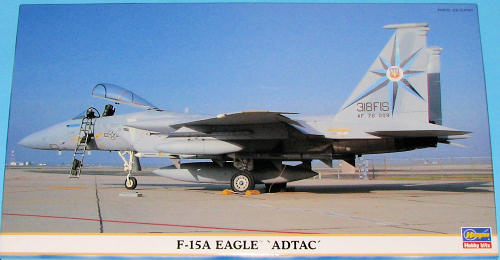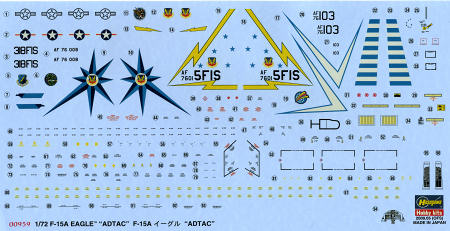
Hasegawa 1/72 F-15A Eagle 'ADTAC;
| KIT #: | 00959 |
| PRICE: | $43.50 SRP |
| DECALS: | Three Options |
| REVIEWER: | Scott Van Aken |
| NOTES: | Limited Reissue. |

| HISTORY |
The Eagle's initial versions were designatedF-15A for the single-seat configuration and F-15B (originally TF-15A, but this designation was quickly deprecated, as the F-15B is fully combat-capable) for the twin-seat. These versions would be powered by new Pratt & Whitney F100 engines to achieve a combat thrust-to-weight ratio in excess of 1 to 1. A proposed 25 mm Ford-Philco GAU-7 cannon with caseless ammunition was dropped in favor of the standard M61 Vulcan gun due to development problems. The F-15 retained conformal carriage of four Sparrow missiles like the Phantom. The fixed wing was put onto a flat, wide fuselage that also provided an effective lifting surface. Some questioned if the zoom performance of the F-15 with Sparrow missiles was enough to deal with the new threat of the high-flying MiG-25 "Foxbat", but its capability was eventually demonstrated in combat.
The first F-15A flight was made in July 1972 with the first flight of the two-seat F-15B (formerly TF-15A) following in July 1973.
The F-15 has a "look-down/shoot-down" radar that can distinguish low-flying moving targets from ground clutter. The F-15 would use computer technology with new controls and displays to lower pilot workload and require only one pilot to save weight. Unlike the F-14 or F-4, the F-15 has only a single canopy frame with clear vision forward. The USAF introduced the F-15 as "the first dedicated USAF air superiority fighter since the F-86 Sabre."
The F-15 would be favored by customers such as the Israel Air Force and Japan Air Self-Defense Force, and the development of the F-15E Strike Eagle would produce a strike fighter that would replace the F-111. However, criticism from the fighter mafia that the F-15 was too large to be a dedicated dogfighter, and too expensive to procure in large numbers to replace the F-4 and A-7, led to the Lightweight Fighter (LWF) program, which led to the USAF F-16 Fighting Falcon and the middle-weight Navy F/A-18 Hornet.
The A model F-15 has been withdrawn from unit service by this time with the C/D/E models carrying on. Thanks to the small numbers of F-22s being produced (and no wonder due to their incredible costs), it seems that the Eagle will be around for longer than most had anticipated.
| THE KIT |
 Opening the box reveals what is to many of us, an old friend. Hasegawa's F-15A/B kit was a brand new tool in the mid 1980's, incorporating the latest in molding technology of the time. It still holds up quite well and for many, is the best Eagle kit in this scale. It also looks like every other 1/72 F-15 kit I've ever seen as there really is only one way to mold an Eagle!
Opening the box reveals what is to many of us, an old friend. Hasegawa's F-15A/B kit was a brand new tool in the mid 1980's, incorporating the latest in molding technology of the time. It still holds up quite well and for many, is the best Eagle kit in this scale. It also looks like every other 1/72 F-15 kit I've ever seen as there really is only one way to mold an Eagle!
The cockpit section includes raised detail on the instrument panel and side consoles as well as decent detailing in the electronics bay behind the cockpit. Decals are also provided for the instruments if you so wish. There is an actuating ram for the canopy so it can be shown in the open position as can be the speed brake, which is normally closed except when using it or showing off at air shows. The modular design of the kit allows for either a single seat or two seat nose to be attached to the rest of the airframe. This forward section is split vertically while the fuselage is split horizontally. There are not any long intake trunks on this kit, though there is a blanking plate with a compressor face. Wings are build separately from the fuselage and slotted on at a later time.
One concession to the more modern F-15A MSIP aircraft that were used later in their life is that the 'turkey feathers' exhaust is not included. The more open and complex-looking burner cans are provided and are to be built up, something that many may find to be a challenge since there are so many small parts. Typical of Hasegawa kits, no weapons are supplied. You have four long range fuel tanks provided, of which you really only need three. Phantom modelers will like having the spare to use on their late use F-4E/Gs. You are provided weapons pylons so if you want to pop the extra dollars for a weapons set, you'll have something to use them on.
 Markings in this boxing are for three squadrons, all no longer flying the Eagle. Perhaps the unit numbers have been relegated to training units or even base support 'squadrons'. Anyway, all of these are in the older color scheme of Light and Dark Compass Ghost Grey FS 36375 and 363220. The colors are very close to each other so often the planes look mono-colored. Markings are for the 5 FIS, 48 FIS and 318 FIS with the 318th shown on the box cover. All are great schemes in my book. The decals are well done and should provide no problems. There are also zillions of data markings, so it will take a bit to get them all in place.
Markings in this boxing are for three squadrons, all no longer flying the Eagle. Perhaps the unit numbers have been relegated to training units or even base support 'squadrons'. Anyway, all of these are in the older color scheme of Light and Dark Compass Ghost Grey FS 36375 and 363220. The colors are very close to each other so often the planes look mono-colored. Markings are for the 5 FIS, 48 FIS and 318 FIS with the 318th shown on the box cover. All are great schemes in my book. The decals are well done and should provide no problems. There are also zillions of data markings, so it will take a bit to get them all in place.
| CONCLUSIONS |
Another excellent limited run reboxing by Hasegawa and a plane that, frankly, a lot of people buy, but I don't see many of them built. A shame, too as they are very nice kits.
| REFERENCES |
September 2009
Thanks to www.dragonmodelsusa.com for the preview kit. Get yours today at your local shop or on-line store. If you would like your product reviewed fairly and fairly quickly , please contactme or see other details in the